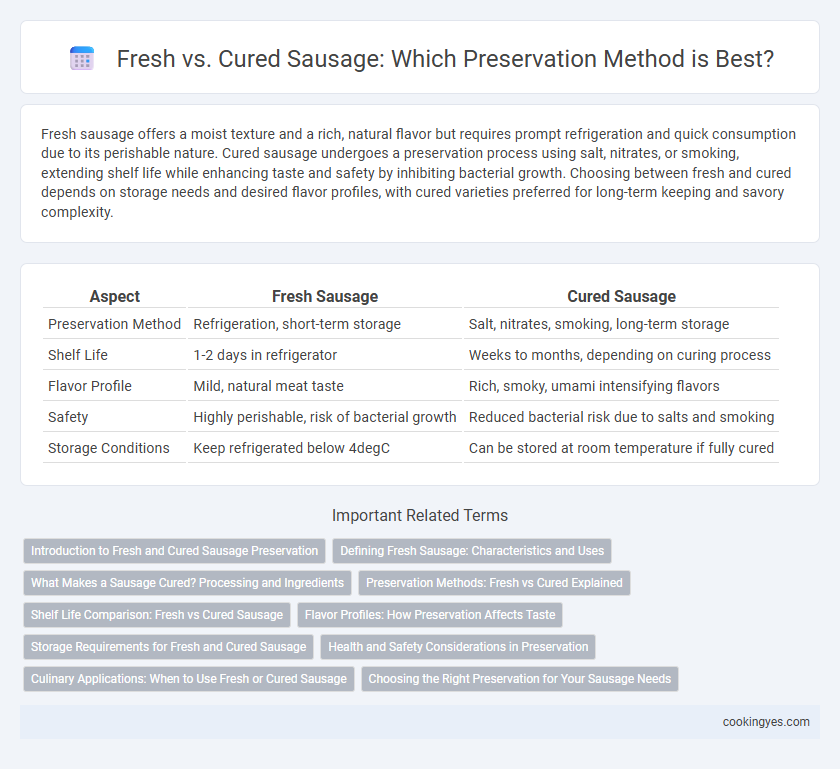Fresh sausage offers a moist texture and a rich, natural flavor but requires prompt refrigeration and quick consumption due to its perishable nature. Cured sausage undergoes a preservation process using salt, nitrates, or smoking, extending shelf life while enhancing taste and safety by inhibiting bacterial growth. Choosing between fresh and cured depends on storage needs and desired flavor profiles, with cured varieties preferred for long-term keeping and savory complexity.
Table of Comparison
| Aspect | Fresh Sausage | Cured Sausage |
|---|---|---|
| Preservation Method | Refrigeration, short-term storage | Salt, nitrates, smoking, long-term storage |
| Shelf Life | 1-2 days in refrigerator | Weeks to months, depending on curing process |
| Flavor Profile | Mild, natural meat taste | Rich, smoky, umami intensifying flavors |
| Safety | Highly perishable, risk of bacterial growth | Reduced bacterial risk due to salts and smoking |
| Storage Conditions | Keep refrigerated below 4degC | Can be stored at room temperature if fully cured |
Introduction to Fresh and Cured Sausage Preservation
Fresh sausages are made from raw ground meat and require immediate refrigeration or freezing to prevent spoilage, as they lack preservatives. Cured sausages undergo a preservation process involving salt, nitrates, or nitrites, which inhibit bacterial growth and extend shelf life while enhancing flavor. The curing method also contributes to the characteristic color and texture of these sausages, making them suitable for longer storage without refrigeration.
Defining Fresh Sausage: Characteristics and Uses
Fresh sausage, characterized by its raw and uncooked state, contains high moisture content and requires refrigeration or freezing to prevent spoilage. It is typically made from ground meat blended with spices and is used in dishes where it is cooked thoroughly before consumption. Unlike cured sausage, fresh sausage lacks preservatives such as nitrates, making it perishable but prized for its fresh flavor and texture.
What Makes a Sausage Cured? Processing and Ingredients
A cured sausage undergoes a preservation process involving curing agents like sodium nitrite or nitrate, which inhibit bacterial growth and enhance flavor and color. The curing process often includes salting, smoking, and fermentation, which together extend shelf life and develop distinctive taste profiles. Fresh sausages lack these curing agents and are typically cooked and consumed shortly after production, requiring refrigeration to prevent spoilage.
Preservation Methods: Fresh vs Cured Explained
Fresh sausages rely on refrigeration and immediate cooking to prevent spoilage, making them highly perishable with a short shelf life. Cured sausages use salt, nitrates, and fermentation processes to inhibit bacterial growth, allowing longer preservation without refrigeration. The curing method enhances flavor complexity and texture, while fresh sausages retain a moist, tender bite best suited for rapid consumption.
Shelf Life Comparison: Fresh vs Cured Sausage
Fresh sausage typically has a short shelf life of 1 to 2 days when refrigerated due to its high moisture content and lack of preservatives. Cured sausage, treated with salt, nitrates, or nitrites, can last several weeks to months under proper storage conditions by inhibiting bacterial growth. Understanding the difference in preservation methods is crucial for maximizing freshness and safety in sausage consumption.
Flavor Profiles: How Preservation Affects Taste
Fresh sausage offers a vibrant, natural flavor highlighting the raw ingredients like pork, herbs, and spices, resulting in a juicy and tender texture. Cured sausage undergoes a preservation process using salt, nitrates, or smoking, which intensifies flavors by adding smoky, tangy, and umami notes while producing a firmer and drier consistency. The preservation method directly influences the complexity and depth of taste, making fresh sausages ideal for mild, savory dishes and cured varieties perfect for robust, bold flavor experiences.
Storage Requirements for Fresh and Cured Sausage
Fresh sausage requires refrigeration at temperatures below 40degF (4degC) and must be consumed within 1 to 2 days to prevent spoilage due to its high moisture content. Cured sausage, treated with salt, nitrates, or smoke, has a longer shelf life and can often be stored at room temperature or refrigerated for several weeks depending on the curing method. Proper packaging such as vacuum sealing further extends the storage duration of cured sausages by limiting exposure to oxygen and bacteria.
Health and Safety Considerations in Preservation
Fresh sausages require immediate refrigeration and consumption within a few days to prevent harmful bacterial growth, posing higher risks of foodborne illnesses if mishandled. Cured sausages contain added salt, nitrates, or nitrites that inhibit microbial activity, extending shelf life and enhancing safety under proper storage. However, excessive intake of cured meats is linked to increased risks of certain cancers due to potential formation of nitrosamines.
Culinary Applications: When to Use Fresh or Cured Sausage
Fresh sausage, known for its mild flavor and soft texture, excels in recipes requiring immediate cooking, such as grilling, sauteing, or incorporating into pasta dishes where the sausage imparts moisture and freshness. Cured sausage, including varieties like salami and chorizo, offers longer shelf life and intense flavors achieved through salt, smoke, or fermentation, making it ideal for charcuterie boards, sandwich toppings, and recipes where robust, concentrated taste is desired. Understanding the preservation method guides culinary use: fresh sausage complements quick, moist cooking techniques, while cured sausage enhances dishes with depth and complexity over extended storage.
Choosing the Right Preservation for Your Sausage Needs
Fresh sausages require immediate refrigeration and have a shorter shelf life, making them ideal for quick consumption or cooking. Cured sausages undergo salt, nitrate, or smoke treatments, extending their preservation and enhancing flavor, suitable for long-term storage. Selecting between fresh and cured depends on desired taste, storage duration, and preparation methods for optimal sausage quality.
Fresh vs Cured for preservation method Infographic

 cookingyes.com
cookingyes.com